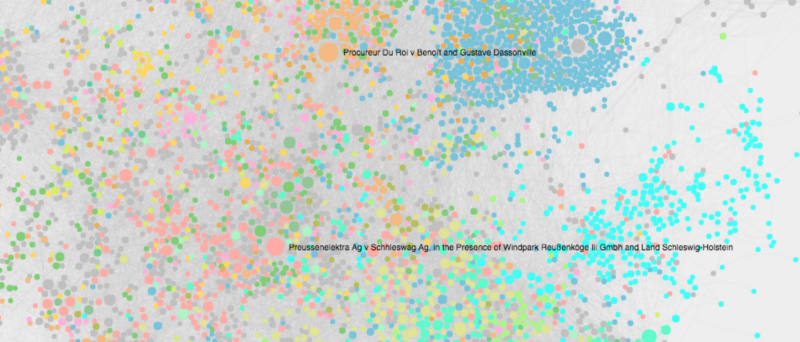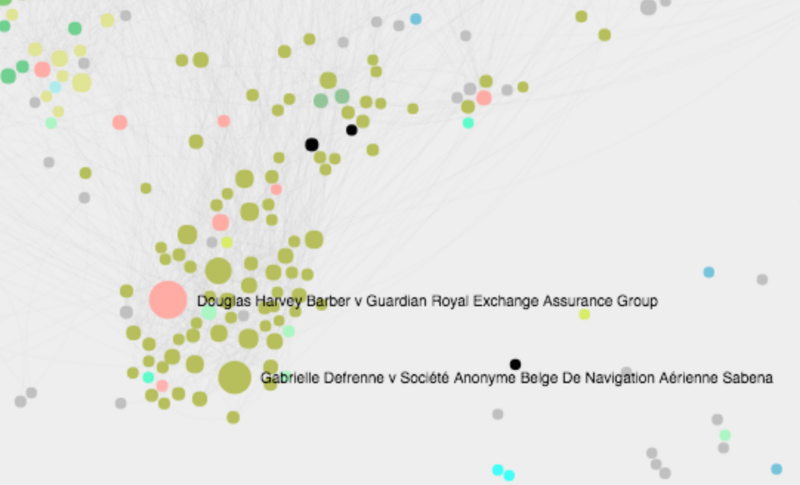Mapping 50,000 citations between European Court of Justice rulings
We mapped how the CJEU cites itself across all its decisions.


As Vizlegal continues on our path to collect and parse millions of court judgments, laws and case filings, we also like to sometimes experiment with the structured data inside our API (Application Programming Interface).
In this example we took at look at a relatively small dataset of decisions of the Court of Justice. The CJEU consists of two courts, the Court of Justice (the superior court) and the General Court (the lower court). As the Court says:
Their primary task is to examine the legality of EU measures and ensure the uniform interpretation and application of EU law.
For this exercise we looking at only decisions of the Court of Justice (also referred to as the ECJ, or European Court of Justice).
We wanted to experiment with two things: 1) how do we group the cases by topic coherently, and 2) how do we visualize the relationships between the documents to add weight for heavily cited judgments.
The corpus of EU law — Eur-Lex maintains a number of category types for each decision of the Court. These include “Categories”, “Subject matter”, “Case Law Directory Code” and “EUROVOC” descriptors.
We decided to use Case Law Directory Code for assigning topics to cases as this was the highest level and most structured. These high level categories have been used for quite a long time, and were enhanced after the adoption of the Lisbon Treaty with more fine-grained classifications of cases.
This change in 2009/2010 presented its only problem, as we were forced to approximate pre-Lisbon categories into post-Lisbon — and this generally worked. However our graph should be viewed with this proviso attached — it is an approximation. (So, for example, under the old classification, a B-02 was a case classified as a case about Free Movement of Goods. Under the new scheme Free Movement of Goods is classed as 4.02)
We then decided to look at how the Court cites itself. We did this by examining every case and analysing how a case is cited by others, and how it cites other cases.
In this graph, every Court of Justice judgment is a “node”, coloured by the Case Law Directory Code and a link is drawn between two nodes when one Court of Justice decision cites another Court of Justice decision (citations to other types of documents such as laws or Advocate General decisions are hidden for now).
The top 3 classes of documents in Court of Justice Judgements are B-19.01 “Actions for failure to fulfil obligations”, B-10.02 “Harmonization of tax legislation”, and B-03.04 “The various common organizations of the agricultural markets”.
Here is the graph as a whole. You will notice nodes are orbiting the cluster — these are cases with little or no citation data, or containing no category.
You will also notice distinct coloured clusters, which represent different classifications of case that the court covered. For example, this is a pink area surrounding cases involving tax:

The case highlighted is C-255/02 Halifax Plc, Leeds Permanent Development Services Ltd and County Wide Property Investments Ltd v Commissioners of Customs & Excise. Halifax is a larger node, and central within its own cluster because of how frequently the case is cited by cases of a similar category.
Another highly noticeable cluster of cases involve C-168/03 Commission of the European Communities v Kingdom of Spain, highlighted in grey here.

All cases in blue fall within the category of B.19.01, or ‘Actions for failure to fulfil obligations’. C-168/03, while within the category of ‘Protection of the health and safety of worker’, is highly referenced by cases within that cluster. The case hinged on whether Spain had fulfilled its obligations to adequately transpose 85/655/EC (as amended by Directive 95/63), which relates to the use of equipment in workplaces.
In general, the blue cases are ones where the Commission has taken action against a Member State. In the case of C-168/03, it was cited 69 times in multiple decisions that followed.
There are also small, discrete, isolated clusters within the corpus. For example here:

The largest node in this quite specific cluster is Case 24/85 Jozef Maria Antonius Spijkers v Gebroeders Benedik Abattoir CV and Alfred Benedik en Zonen BV. The cases in this cluster all fall within the category of B.15.02, or ‘Employment protection and protection of employees in the event of the insolvency of their employer’.
The Spijkers case was referred by the Supreme Court of the Netherlands and related to Directive 77/187 and how to interpret the ‘transfer of an undertaking, business or part of a business to another employer’. It is cited 21 time directly by other cases, and is also highly cited among cases one node away from itself.
This Spijkers case led to what are referred to as ‘Spijkers Criteria’ when it comes to deciding whether there has been a transfer of an undertaking, or not.
Lastly, we turn to another highly concentrated cluster of citations.

The lawyers among you will immediately recognise Case 43/75 Defrenne v Sabena, a significant case in the history of EU law related to equality (indeed the green topic category you see is B.15.01 / Equality) and to the concept of horizontal effect. There’s a brief summary of the case over on Wikipedia.
You will also notice the highly cited C-262/88 Barber v Guardian Royal Exchange Assurance Group. The red colour category is specifically the quite common ‘reference for a preliminary ruling’ but it is highly centred inside the green cluster because of its close relationship to equality and equality of pay.
At the very least, visualising this type of information is both somewhat informative and perhaps even fun. People who have no idea about the history of European law might find it easier to navigate it in a visual way than they would paging through countless text documents trying to get to grips with what their rights might be.
This was also a basic effort, the ‘hairball’ nature of the graph can also be improved as classification is improved with it. There’s lots of work to be done.
From a legal perspective we think it may serve multiple purposes, including: making it easier to find relevant results but in a visual rather than relevancy-based way; improving the classification of the CJEU’s corpus; and improving algorithms generally for finding the right result related to any query.
If you’re interested in the data we are collecting and the tools we are building at Vizlegal, please do drop us a line: hello@vizlegal.com
If you’d like to sign up to our mailing list or try out our product please sign up here.
If you’re interested in the underlying data and exploring litigation data further please contact us for consultancy inquiries.
